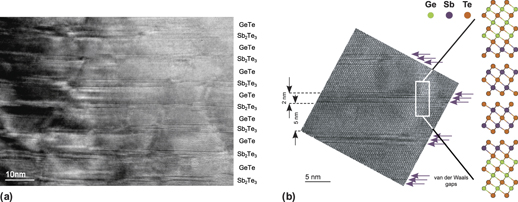Crossref Citations
This article has been cited by the following publications. This list is generated based on data provided by
Crossref.
Momand, Jamo
Wang, Ruining
Boschker, Jos E.
Verheijen, Marcel A.
Calarco, Raffaella
and
Kooi, Bart J.
2017.
Dynamic reconfiguration of van der Waals gaps within GeTe–Sb2Te3 based superlattices.
Nanoscale,
Vol. 9,
Issue. 25,
p.
8774.
Song, Young-Sun
Kim, Jeongwoo
and
Jhi, Seung-Hoon
2017.
Pair potential modeling of atomic rearrangement in GeTe-Sb2Te3 superlattice via first-principles calculations.
Journal of Applied Physics,
Vol. 121,
Issue. 9,
Boschker, Jos E.
and
Calarco, Raffaella
2017.
Growth of crystalline phase change materials by physical deposition methods.
Advances in Physics: X,
Vol. 2,
Issue. 3,
p.
675.
Wang, Jiang-Jing
Xu, Ya-Zhi
Mazzarello, Riccardo
Wuttig, Matthias
and
Zhang, Wei
2017.
A Review on Disorder-Driven Metal–Insulator Transition in Crystalline Vacancy-Rich GeSbTe Phase-Change Materials.
Materials,
Vol. 10,
Issue. 8,
p.
862.
Lotnyk, Andriy
Ross, Ulrich
Dankwort, Torben
Hilmi, Isom
Kienle, Lorenz
and
Rauschenbach, Bernd
2017.
Atomic structure and dynamic reconfiguration of layered defects in van der Waals layered Ge-Sb-Te based materials.
Acta Materialia,
Vol. 141,
Issue. ,
p.
92.
Hilmi, Isom
Lotnyk, Andriy
Gerlach, Jürgen W.
Schumacher, Philipp
and
Rauschenbach, Bernd
2017.
Research Update: Van-der-Waals epitaxy of layered chalcogenide Sb2Te3 thin films grown by pulsed laser deposition.
APL Materials,
Vol. 5,
Issue. 5,
Behrens, Mario
Lotnyk, Andriy
Roß, Ulrich
Griebel, Jan
Schumacher, Philipp
Gerlach, Jürgen W.
and
Rauschenbach, Bernd
2018.
Impact of disorder on optical reflectivity contrast of epitaxial Ge2Sb2Te5 thin films.
CrystEngComm,
Vol. 20,
Issue. 26,
p.
3688.
Kowalczyk, Philippe
Hippert, Françoise
Bernier, Nicolas
Mocuta, Cristian
Sabbione, Chiara
Batista‐Pessoa, Walter
and
Noé, Pierre
2018.
Impact of Stoichiometry on the Structure of van der Waals Layered GeTe/Sb2Te3 Superlattices Used in Interfacial Phase‐Change Memory (iPCM) Devices.
Small,
Vol. 14,
Issue. 24,
Hatayama, Shogo
Sutou, Yuji
Shindo, Satoshi
Saito, Yuta
Song, Yun-Heub
Ando, Daisuke
and
Koike, Junichi
2018.
Inverse Resistance Change Cr2Ge2Te6-Based PCRAM Enabling Ultralow-Energy Amorphization.
ACS Applied Materials & Interfaces,
Vol. 10,
Issue. 3,
p.
2725.
Wang, Ruining
Lange, Felix R. L.
Cecchi, Stefano
Hanke, Michael
Wuttig, Matthias
and
Calarco, Raffaella
2018.
2D or Not 2D: Strain Tuning in Weakly Coupled Heterostructures.
Advanced Functional Materials,
Vol. 28,
Issue. 14,
Suzuki, Takara
Saito, Yuta
Fons, Paul
Kolobov, Alexander V.
Tominaga, Junji
and
Hase, Muneaki
2018.
All‐Optical Detection of Periodic Structure of Chalcogenide Superlattice Using Coherent Folded Acoustic Phonons.
physica status solidi (RRL) – Rapid Research Letters,
Vol. 12,
Issue. 9,
Lotnyk, Andriy
Hilmi, Isom
Ross, Ulrich
and
Rauschenbach, Bernd
2018.
Van der Waals interfacial bonding and intermixing in GeTe-Sb2Te3-based superlattices.
Nano Research,
Vol. 11,
Issue. 3,
p.
1676.
Lewin, Martin
Mester, Lars
Saltzmann, Tobias
Chong, Seung-Jae
Kaminski, Marvin
Hauer, Benedikt
Pohlmann, Marc
Mio, Antonio M.
Wirtssohn, Matti
Jost, Peter
Wuttig, Matthias
Simon, Ulrich
and
Taubner, Thomas
2018.
Sb2Te3 Growth Study Reveals That Formation of Nanoscale Charge Carrier Domains Is an Intrinsic Feature Relevant for Electronic Applications.
ACS Applied Nano Materials,
Vol. 1,
Issue. 12,
p.
6834.
Bragaglia, Valeria
Arciprete, Fabrizio
Mio, Antonio M.
and
Calarco, Raffaella
2018.
Designing epitaxial GeSbTe alloys by tuning the phase, the composition, and the vacancy ordering.
Journal of Applied Physics,
Vol. 123,
Issue. 21,
Cojocaru-Mirédin, Oana
Hollermann, Henning
Mio, Antonio M
Wang, Anthony Yu-Tung
and
Wuttig, Matthias
2019.
Role of grain boundaries in Ge–Sb–Te based chalcogenide superlattices.
Journal of Physics: Condensed Matter,
Vol. 31,
Issue. 20,
p.
204002.
Kooi, Bart J.
and
Momand, Jamo
2019.
High Resolution Imaging of Chalcogenide Superlattices for Data Storage Applications: Progress and Prospects.
physica status solidi (RRL) – Rapid Research Letters,
Vol. 13,
Issue. 4,
Hollermann, Henning
Lange, Felix R. L.
Jakobs, Stefan
Kerres, Peter
and
Wuttig, Matthias
2019.
Stoichiometry Determination of Chalcogenide Superlattices by Means of X‐Ray Diffraction and its Limits.
physica status solidi (RRL) – Rapid Research Letters,
Vol. 13,
Issue. 4,
Behrens, Mario
Lotnyk, Andriy
Gerlach, Jürgen W.
Ehrhardt, Martin
Lorenz, Pierre
and
Rauschenbach, Bernd
2019.
Direct Measurement of Crystal Growth Velocity in Epitaxial Phase-Change Material Thin Films.
ACS Applied Materials & Interfaces,
Vol. 11,
Issue. 44,
p.
41544.
Huang, Yin
Liu, Furong
Zhang, Yongzhi
Li, Wenqiang
Han, Gang
Sun, Nianxiang
and
Liu, Feng
2019.
Effects of biaxial strain on interfacial intermixing and local structures in strain engineered GeTe-Sb2Te3 superlattices.
Applied Surface Science,
Vol. 493,
Issue. ,
p.
904.
Tominaga, Junji
2019.
The Design and Application on Interfacial Phase‐Change Memory.
physica status solidi (RRL) – Rapid Research Letters,
Vol. 13,
Issue. 4,




